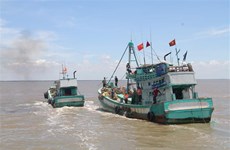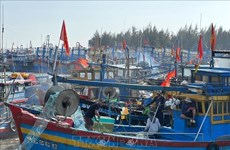Mekong Delta fights salinisation, drought
The Mekong River Delta is grappling with severe drought and salinisation
that could damage agricultural production in the country’s rice bowl.
The Mekong River Delta is grappling with severe drought and salinisation
that could damage agricultural production in the country’s rice bowl.
According to the Southern Irrigation Science Research Institute, in early April, salty water has snapped up about 70 km on seven branches of the Cuu Long, Ong Doc and Cai Lon rivers.
On Cua Tieu river, saline water has reached Ngu Hiep commune, Chau Thanh district, Tien Giang province while on Cua Dai river, it has gone to Phu Duc commune, Chau Thanh district, Ben Tre province.
Salinisation has also hit other localities in the region, including Tra Vinh, Soc Trang, Vinh Long, Hau Giang and Kien Giang.
The Southern Hydrometeorological Station forecasts the hot weather will last until the end of May, affecting the summer-spring crop this year.
An estimated 300,000 hectares of rice fields in the region will be affected by salinisation and drought during this year’s dry season, of which over 100,000 hectares will suffer direct impacts.
Currently, the coastal provinces, especially Soc Trang, Tien Giang and Ben Tre, are facing a serious shortage of fresh water for crops.
In Ben Tre province alone, 4,200 hectares of crops and orchards have seen productivity decrease.
Mekong Delta provinces are making all-out efforts to cope with the worse situation.
Ben Tre has planned to spend tens of billions of Vietnam dong on fighting drought and salinisation during the period of 2013-2014. The province has also instructed its localities to build irrigation facilities in order to reduce losses in crops and livestock.
Kien Giang has built 95 anti-salinity dams, dredged canals, repaired irrigation stations and closed flood gates while taking fresh water from Hau river for production.
Meanwhile, Tra Vinh has actively hoarded up fresh water and closed drains to prevent saline water.-VNA
According to the Southern Irrigation Science Research Institute, in early April, salty water has snapped up about 70 km on seven branches of the Cuu Long, Ong Doc and Cai Lon rivers.
On Cua Tieu river, saline water has reached Ngu Hiep commune, Chau Thanh district, Tien Giang province while on Cua Dai river, it has gone to Phu Duc commune, Chau Thanh district, Ben Tre province.
Salinisation has also hit other localities in the region, including Tra Vinh, Soc Trang, Vinh Long, Hau Giang and Kien Giang.
The Southern Hydrometeorological Station forecasts the hot weather will last until the end of May, affecting the summer-spring crop this year.
An estimated 300,000 hectares of rice fields in the region will be affected by salinisation and drought during this year’s dry season, of which over 100,000 hectares will suffer direct impacts.
Currently, the coastal provinces, especially Soc Trang, Tien Giang and Ben Tre, are facing a serious shortage of fresh water for crops.
In Ben Tre province alone, 4,200 hectares of crops and orchards have seen productivity decrease.
Mekong Delta provinces are making all-out efforts to cope with the worse situation.
Ben Tre has planned to spend tens of billions of Vietnam dong on fighting drought and salinisation during the period of 2013-2014. The province has also instructed its localities to build irrigation facilities in order to reduce losses in crops and livestock.
Kien Giang has built 95 anti-salinity dams, dredged canals, repaired irrigation stations and closed flood gates while taking fresh water from Hau river for production.
Meanwhile, Tra Vinh has actively hoarded up fresh water and closed drains to prevent saline water.-VNA













